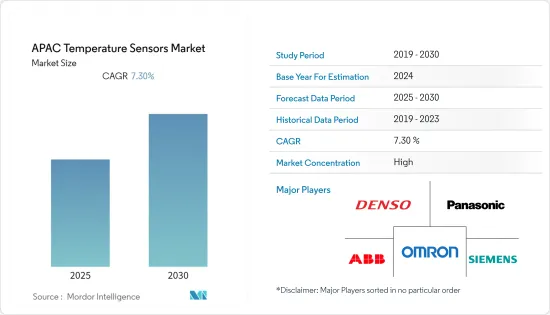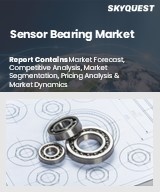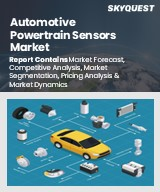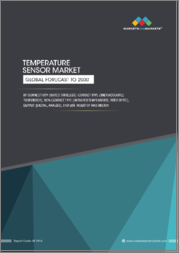
|
시장보고서
상품코드
1628732
아시아태평양의 온도 센서 - 시장 점유율 분석, 산업 동향 및 통계, 성장 예측(2025-2030년)APAC Temperature Sensors - Market Share Analysis, Industry Trends & Statistics, Growth Forecasts (2025 - 2030) |
||||||
■ 보고서에 따라 최신 정보로 업데이트하여 보내드립니다. 배송일정은 문의해 주시기 바랍니다.
아시아태평양의 온도 센서 시장은 예측 기간 동안 CAGR 7.3%를 나타낼 것으로 예상됩니다.

주요 하이라이트
- 석유 및 가스, 화학 및 석유화학 산업은 이 지역에서 가장 두드러진 온도 센서 수요처입니다. 정유 공장, 화학 및 석유화학 처리 공장, 금속, 광업 및 제조 산업의 주요 거점 중 하나인 이 지역에서는 온도 센서에 대한 수요가 증가하고 있습니다. 석유 및 가스 부문에서 사용되는 공압 및 유압은 온도 센서의 주요 응용 분야입니다. 최근 몇 년동안 오일 패치의 인프라 구축이 진행되면서 온도 센서에 대한 수요도 증가하고 있습니다.
- 인도 자동차 산업은 경제적으로나 인구통계학적으로 성장하기 좋은 위치에 있으며, 국내 관심과 수출 잠재력 모두에 기여하고 있습니다. 인도 정부는 '메이크 인 인디아(Make in India)' 계획의 일환으로 자동차 제조를 계획의 주요 동력으로 삼고 있습니다. 이 계획은 자동차 미션 플랜(AMP) 2016-2026에서 강조한 바와 같이, 2026년까지 승용차 시장이 3배 증가한 940만 대까지 확대될 것으로 예상하고 있습니다. 이는 이 지역의 자동차 부문에서 온도 센서의 채택을 증가시킬 것으로 예상됩니다.
- 중국 천연자원부에 따르면 2020년 5월 1일부터 순자산이 3억 위안(4,300만 달러)을 넘지 않는 중국 등록 외국 기업은 석유 및 가스 탐사 및 생산에 참여할 수 있다고 밝혔습니다. 이번 조치는 중국이 석유 및 가스 개발을 확대하고 민간 자본을 업스트림 에너지 사업에 참여시키려는 노력의 일환으로, 2019년 중국은 1,730억 입방미터의 천연가스와 1억 9,100만 톤의 석유를 생산했습니다. 업스트림 탐사 및 생산에 대한 연간 투자액은 3,320억 위안(478억 달러)에 달했습니다. 이 지역의 산업 발전은 석유 및 가스 산업에서 응용 분야가 확대되면서 온도 센서의 성장을 주도하고 있습니다.
- 이 지역의 의료 분야에서도 온도 센서가 많이 활용되고 있습니다. 예를 들어, 2020년 1월 말, 상하이 공중보건임상센터(SPHCC)는 미국에 본사를 둔 커넥티드 헬스 스타트업 VivaLNK의 연속 온도 센서를 사용하여 코로나19 환자 모니터링에 활용함으로써 의료진이 바이러스에 노출될 위험을 크게 줄였습니다. 4월, SPHCC는 블루투스 IoT 제품 및 솔루션 제공업체인 Cassia Network의 게이트웨이와 VivaLNK의 의료용 온도 센서를 결합하여 코로나19 환자 모니터링에 활용하고 있다고 발표했습니다.
아시아태평양의 온도 센서 시장 동향
소비자용 전자제품이 크게 성장
- India Brand Equity Foundation(IBEF)에 따르면, 인도의 소비자 가전 및 소비자 가전(ACE) 시장은 연평균 9%의 성장률을 기록하며 2022년 3조 1,500억 루피(483억 7,000만 달러)에 달할 것으로 예상됩니다. 이는 예측 기간 동안 온도 센서 시장의 성장을 가속할 것으로 예상됩니다. 이 지역에서는 온도 센서가 내장된 여러 소비자 전자제품이 출시되고 있습니다.
- 일본은 정유 부문이 필요로 하는 경질원유를 효율적으로 조달할 수 있는 전략적 공간을 도입하여 국가 석유 비축의 유연성을 높이기 위한 노력을 기울이고 있습니다. 또한, 이 지역은 소비자 전자제품 시장의 주요 부품 생산지이며, 온도 센서의 중요한 사용자 중 하나입니다.
- 몇몇 현지 기업들이 온도 센서를 내장한 제품을 출시하고 있습니다. 예를 들어, 2020년 6월, DetelPro는 세계에서 가장 저렴한 적외선 온도계로 알려진 'Make in Bharat'의 출시를 발표했습니다. 이 제품은 2년 보증이 제공되며 가격은 INR 999 GST입니다.
- 2020년 10월, 전자 기업 Hammer는 Pulse 스마트워치를 출시하며 인도에서 제품 포트폴리오를 확장했습니다. 이 새로운 스마트워치는 온도 센서가 장착되어 있으며, 1주일 동안 배터리를 사용할 수 있으며, 가격은 2,799루피(약 30만원)입니다. 이번 제품 출시는 인도에서 온도 센서가 탑재된 스마트워치에 대한 수요가 많다는 것을 보여줍니다.
자동차가 가장 높은 시장 점유율을 차지
- 우리 정부는 자율주행차를 적극적으로 추진하고 있습니다. 한국은 세계 주요 자동차 제조국 중 하나이기 때문에 새로운 산업을 선도하는 ADAS 개발에 대한 수요가 큽니다. 따라서 예측 기간 동안 온도 센서의 광범위한 채택이 예상됩니다.
- 중국 정부도 자동차 부품 부문을 포함한 자국 자동차 산업을 뛰어난 산업 중 하나로 간주하고 있습니다. 중국 중앙 정부는 2020년까지 중국의 자동차 생산량이 3,000만 대, 2025년까지 3,500만 대에 달할 것으로 예상하고 있습니다. 따라서 자동차 산업은 중국에서 온도 센서의 중요한 응용 분야 중 하나가 될 것으로 보입니다. 그러나 중국자동차공업협회는 코로나19 사태로 인해 2020년 전망치를 수정하여 상반기 판매량이 10% 가까이 감소하고 연간 5% 감소할 것으로 예상하고 있습니다.
- 2020년 8월, 한국은 온도 센서와 UV 램프가 장착되어 온도가 37.5℃ 이하일 때만 문이 슬라이딩으로 열리는 바이러스 방지 버스 쉼터를 설치했습니다. 서울 동북부 지역에 10개의 첨단 버스쉼터 시설이 설치되어 몬순 비와 여름 더위, 코로나19로부터 승객들을 보호하고 있습니다.
아시아태평양의 온도 센서 산업 개요
아시아태평양의 온도 센서 시장은 경쟁이 치열하고 여러 대기업으로 구성되어 있습니다. 시장 점유율 측면에서 보면, 현재 시장을 독점하고 있는 주요 업체는 소수에 불과합니다. 그러나 많은 기업들이 혁신적이고 지속 가능한 패키징을 통해 새로운 계약을 체결하고 새로운 시장을 개척함으로써 시장에서의 입지를 강화하고 있습니다.
- 2020년 12월 - NTC, PTC 서미스터, 온도 센서 등의 부품을 제조하는 대만의 Thinking Electronic Industrial은 세계 자동차 판매 회복과 함께 2021년에 자동차 출하량이 크게 증가할 것으로 예상하고 있습니다. 이 회사에 따르면 이 회사의 NTC 및 PTC 서미스터와 온도 센서는 LED 자동 조명, 차량 제어 장치, 차량용 엔터테인먼트 시스템, 동력 전달 시스템, 충전 파일, 차량용 충전기, 배터리 팩, 차량용 모터에 광범위하게 적용되고 있다고 합니다.
기타 혜택
- 엑셀 형식 시장 예측(ME) 시트
- 3개월간의 애널리스트 지원
목차
제1장 서론
- 조사의 전제조건과 시장 정의
- 조사 범위
제2장 조사 방법
제3장 주요 요약
제4장 시장 역학
- 시장 개요
- COVID-19산업에 대한 영향 평가
- 시장 성장 촉진요인
- 인더스트리 4.0으로 고속 공장 자동화 성장
- 소비자 일렉트로닉스 웨어러블 수요 증가
- 시장 성장 억제요인
- 원료 가격 변동
- 밸류체인 분석
- 산업 매력 - Porter의 Five Forces 분석
- 공급 기업의 교섭력
- 바이어의 교섭력
- 신규 진출업체의 위협
- 대체품의 위협
- 경쟁 기업간 경쟁 관계
제5장 시장 세분화
- 유형
- 유선
- 무선
- 기술
- 적외선
- 열전대
- 저항 온도 검출기
- 서미스트
- 온도 트랜스미터
- 광섬유
- 기타
- 최종사용자 산업
- 화학제품 및 석유화학제품
- 석유 및 가스
- 금속 및 광업
- 발전
- 식품 및 음료
- 자동차
- 의료
- 항공우주·군
- 가전제품
- 기타
- 국가명
- 중국
- 인도
- 일본
- 한국
- 기타 아시아태평양
제6장 경쟁 구도
- 기업 개요
- Siemens AG
- Panasonic Corporation
- Texas Instruments Incorporated
- Honeywell International Inc.
- ABB Ltd
- Analog Devices Inc.
- Fluke Process Instruments
- Emerson Electric Company
- STMicroelectronics
- Microchip Technology Incorporated
- NXP Semiconductors NV
- GE Sensing & Inspection Technologies GmbH
- Robert Bosch GmbH
- Gunther GmbH Temperaturmesstechnik
- TE Connectivity Ltd
- Denso Corporation
- Omron Corporatio
- FLIR Systems
- Thermometris
- Maxim Integrated Products
- Kongsberg Gruppen
제7장 투자 분석
제8장 시장의 미래
LSH 25.01.21The APAC Temperature Sensors Market is expected to register a CAGR of 7.3% during the forecast period.

Key Highlights
- The oil and gas and chemical/petrochemical industries are some of the most prominent consumers of temperature sensors in the region. Being one of the major hubs for refineries, chemical and petrochemical processing plants, and metals, mining, and manufacturing, the region has been experiencing an increase in the demand for temperature sensors. The pneumatics and hydraulics used in the oil and gas sector are the major applications for temperature sensors. The infrastructure build-out in the oil patches has increased in recent years, thereby translating the demand for temperature sensors.
- The Indian automotive industry is well-positioned for growth, economically and demographically, serving both domestic interest and export possibilities, which are set to rise in the near future. As a part of the "Make In India" scheme, the Government of India aims to make automobile manufacturing the main driver for the initiative. The scheme expects the passenger vehicles market to triple to 9.4 Million units by 2026, as highlighted in the Auto Mission Plan (AMP) 2016-2026. This factor is expected to rise the adoption of temperature sensors in the automotive sector of the region.
- According to the Ministry of Natural Resources, from May 1, 2020, foreign firms registered in China with net assets no lower than CNY 300 Million (USD 43 Million) would be allowed to participate in oil and gas exploration and production. This move comes as part of Beijing's push to increase oil and gas development and bring private capital into the upstream energy business. In 2019, China produced 173 billion cubic meters of natural gas and 191 Million metric tons of oil. Annual investment in upstream exploration and production was CNY 332 billion (USD 47.8 billion). The development of industries in the region has been driving the growth of temperature sensors, owing to their growing applications in the oil and gas industry.
- The medical sector of the region has also been significantly utilizing a temperature sensor. For instance, at the end of January 2020, Shanghai Public Health Clinical Center (SPHCC) utilized US-based connected health startup VivaLNK's continuous temperature sensor to monitor COVID-19 patients, which has been considerably reducing the risks of healthcare workers being exposed to the virus. In April 2020, SPHCC announced that they are utilizing Bluetooth IoT products and solutions provider Cassia Network's gateways, coupled with VivaLNK's medical temperature sensors to monitor COVID-19 patients.
Asia-Pacific Temperature Sensor Market Trends
Consumer Electronics to Show Significant Growth
- According to the India Brand Equity Foundation (IBEF), the Indian appliances and consumer electronics (ACE) market are expected to register a CAGR of 9% to reach INR 3.15 trillion (USD 48.37 billion) in 2022. This is expected to boost the temperature sensors market growth over the forecast period. Multiple consumer electronic products have been launching in the region that incorporates temperature sensors.
- Japan has been making efforts toward boosting its flexibility with the national petroleum reserves by introducing strategic space that will allow the country to efficiently procure crude oil that is in line with the refining sector's requirement for lighter grades. The region is also a major manufacturer of components to the consumer electronics market, which is one of the significant users of temperature sensors in the area.
- Several local companies have been launching products incorporating temperature sensors. For instance, in June 2020, DetelPro announced the launch of its 'Make in Bharat,' reportedly the world's most low-cost infrared thermometer. The launched product comes with two years of warranty and is priced at INR 999 + GST.
- In October 2020, an electronics company, Hammer, expanded its product portfolio in India with the launch of its Pulse smartwatch. The new smartwatch from the company comes with a temperature sensor and claims to offer a one-week battery life and a price of INR 2,799. The product launches show that there is a significant demand for smartwatches incorporating temperature sensors in India.
Automotive to Hold the Highest Market Share
- The South Korean government has been actively promoting autonomous vehicles. As South Korea is one of the major car manufacturing countries globally, there is a massive demand for developing ADAS to lead the new industry. This is expected to lead to the broad adoption of temperature sensors over the forecast period.
- The Chinese government also views its automotive industry, including the auto parts sector, as one of the prominent industries. The country's Central Government expects China's automobile output to reach 30 Million units by 2020 and 35 Million units by 2025. This is posed to make the automotive sector one of the prominent uses of temperature sensors in China. However, the China Association of Automobile Manufacturers revised the predictions for 2020, forecasting an almost 10% drop in sales for the first half of the year and 5% for the full year, based on the COVID-19 outbreak.
- In August 2020, South Korea installed anti-virus bus shelters with temperature sensors and UV lamps, where the door will slide open only if their temperature is below 37.5C. Ten advanced bus shelter facilities have been installed in a north-eastern district of Seoul, offering protection from monsoon rains and summer heat and COVID-19.
Asia-Pacific Temperature Sensor Industry Overview
The Asia Pacific Temperature Sensor Market is highly competitive and consists of several major players. In terms of market share, few of the major players currently dominate the market. However, with innovative and sustainable packaging, many of the companies are increasing their market presence by securing new contracts and by tapping new markets.
- December 2020 - Taiwan-based Thinking Electronic Industrial engaged in the production of components, such as NTC and PTC thermistors and temperature sensors, expects its shipments for the automotive landscape to increase significantly in 2021, coupled with the recovery of global vehicle sales. According to the company, its NTC and PTC thermistors and temperature sensors have been significantly applied to LED auto lights, vehicle control units, in-car entertainment systems, power transmission systems, charging piles, in-vehicle chargers, battery packs, and automotive motors.
Additional Benefits:
- The market estimate (ME) sheet in Excel format
- 3 months of analyst support
TABLE OF CONTENTS
1 INTRODUCTION
- 1.1 Study Assumptions and Market Definition
- 1.2 Scope of the Study
2 RESEARCH METHODOLOGY
3 EXECUTIVE SUMMARY
4 MARKET DYNAMICS
- 4.1 Market Overview
- 4.2 Assessment of Impact of COVID-19 on the Industry
- 4.3 Market Drivers
- 4.3.1 Growth in Industry 4.0 & Rapid Factory Automation
- 4.3.2 Increasing Demand for Wearable in Consumer Electronics
- 4.4 Market Restraints
- 4.4.1 Fluctuation in Raw Material Prices
- 4.5 Industry Value Chain Analysis
- 4.6 Industry Attractiveness - Porter's Five Force Analysis
- 4.6.1 Bargaining Power of Suppliers
- 4.6.2 Bargaining Power of Buyers
- 4.6.3 Threat of New Entrants
- 4.6.4 Threat of Substitute Products
- 4.6.5 Intensity of Competitive Rivalry
5 MARKET SEGMENTATION
- 5.1 Type
- 5.1.1 Wired
- 5.1.2 Wireless
- 5.2 Technology
- 5.2.1 Infrared
- 5.2.2 Thermocouple
- 5.2.3 Resistance Temperature Detector
- 5.2.4 Thermistor
- 5.2.5 Temperature Transmitter
- 5.2.6 Fiber Optic
- 5.2.7 Others
- 5.3 End-user Industry
- 5.3.1 Chemical & Petrochemical
- 5.3.2 Oil and Gas
- 5.3.3 Metal and Mining
- 5.3.4 Power Generation
- 5.3.5 Food and Beverage
- 5.3.6 Automotive
- 5.3.7 Medical
- 5.3.8 Aerospace and Military
- 5.3.9 Consumer Electronics
- 5.3.10 Other End-user Industries
- 5.4 Country
- 5.4.1 China
- 5.4.2 India
- 5.4.3 Japan
- 5.4.4 South Korea
- 5.4.5 Rest of Asia Pacific
6 COMPETITIVE LANDSCAPE
- 6.1 Company Profiles
- 6.1.1 Siemens AG
- 6.1.2 Panasonic Corporation
- 6.1.3 Texas Instruments Incorporated
- 6.1.4 Honeywell International Inc.
- 6.1.5 ABB Ltd
- 6.1.6 Analog Devices Inc.
- 6.1.7 Fluke Process Instruments
- 6.1.8 Emerson Electric Company
- 6.1.9 STMicroelectronics
- 6.1.10 Microchip Technology Incorporated
- 6.1.11 NXP Semiconductors NV
- 6.1.12 GE Sensing & Inspection Technologies GmbH
- 6.1.13 Robert Bosch GmbH
- 6.1.14 Gunther GmbH Temperaturmesstechnik
- 6.1.15 TE Connectivity Ltd
- 6.1.16 Denso Corporation
- 6.1.17 Omron Corporatio
- 6.1.18 FLIR Systems
- 6.1.19 Thermometris
- 6.1.20 Maxim Integrated Products
- 6.1.21 Kongsberg Gruppen
7 INVESTMENT ANALYSIS
8 FUTURE OF THE MARKET
샘플 요청 목록



















